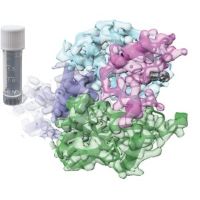Specification
| Description | Recombinant protein from the full-length sequence of Homo sapiens HUS1 checkpoint clamp component (HUS1), transcript variant 1 (NM_004507). |
| Organism | Homo sapiens (Human) |
| Expression Host | Human Cells |
| Tag Info | His or DYKDDDDK. Please contact us if you need further information or require specific designed tag. |
| Purity | Greater than 90% by SDS-PAGE gel |
| Uniprot ID | O60921 |
| Entry Name | HUS1_HUMAN |
| Gene Names | HUS1 |
| Alternative Gene Names | |
| Alternative Protein Names | Checkpoint protein HUS1 (hHUS1) |
| Application | Antigens, Western, ELISA and other in vitro binding or in vivo functional assays, and protein-protein interaction studies; For research & development use only! |
| Buffer | Purified protein formulated in a sterile solution of PBS buffer, pH7.2, without any preservatives |
| Endotoxin | Endotoxin level is < 0.1 ng/µg of protein (<1EU /µg) |
| Length | 280 |
| Molecular Weight(Da) | 31691 |
| Protein Sequence | (The sequence of expressed protein may have some variation from the sequence shown below. Please contact us for the exact sequence.) MKFRAKIVDGACLNHFTRISNMIAKLAKTCTLRISPDKLNFILCDKLANGGVSMWCELEQENFFNEFQMEGVSAENNEIYLELTSENLSRALKTAQNARALKIKLTNKHFPCLTVSVELLSMSSSSRIVTHDIPIKVIPRKLWKDLQEPVVPDPDVSIYLPVLKTMKSVVEKMKNISNHLVIEANLDGELNLKIETELVCVTTHFKDLGNPPLASESTHEDRNVEHMAEVHIDIRKLLQFLAGQQVNPTKALCNIVNNKMVHFDLLHEDVSLQYFIPALS |
Background
| Function | FUNCTION: Component of the 9-1-1 cell-cycle checkpoint response complex that plays a major role in DNA repair. The 9-1-1 complex is recruited to DNA lesion upon damage by the RAD17-replication factor C (RFC) clamp loader complex. Acts then as a sliding clamp platform on DNA for several proteins involved in long-patch base excision repair (LP-BER). The 9-1-1 complex stimulates DNA polymerase beta (POLB) activity by increasing its affinity for the 3'-OH end of the primer-template and stabilizes POLB to those sites where LP-BER proceeds; endonuclease FEN1 cleavage activity on substrates with double, nick, or gap flaps of distinct sequences and lengths; and DNA ligase I (LIG1) on long-patch base excision repair substrates. The 9-1-1 complex is necessary for the recruitment of RHNO1 to sites of double-stranded breaks (DSB) occurring during the S phase. {ECO:0000269|PubMed:21659603}. |
| Pathway | |
| Protein Families | HUS1 family |
| Tissue Specificity |
QC Data
| Note | Please contact us for QC Data |
| Product Image (Reference Only) |  |

